|
Museum
|
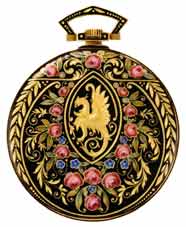
The Griffin Patek, Philippe
& Co, Geneva, N° 860’163 Open-face keyless-winding dress-watch - Cloisonné
enamel décor - 1937.
PATEK PHILIPPE MUSEUM
The first floor (I) :
THE PATEK PHILIPPE COLLECTION
From 1839 to the present day
Watches had existed for almost three centuries and a half when the Polish Count Antoine Norbert de Patek founded the future watchmaking firm of Patek Philippe with his fellow countryman, François Czapek, in Geneva in 1839. In just a few years, with the arrival of a new partner, the talented French horologist, Adrien Philippe, in 1845, the Geneva firm acquired a reputation for excellence. Through 163 years of uninterrupted production it has built on that reputation, which continues to flourish. The PATEK PHILIPPE MUSEUM retraces the history of the most creative watchmaking firm of our times, a history filled with technical and aesthetic innovations and illustrated by over 1000 exceptional timepieces.
Patek and Czapek,
two Polish exiles
In 1831, following an uprising that was severely repressed by the Russian
occupation, Poland lost all independence and thousands of patriots left
the country. Amongst them was Count Antoine Norbert de Patek, a young
cavalry officer who took refuge in Geneva, where he set up business in
1832 dealing in fine watches. This passionate connoisseur of the fine
arts joined up seven years later with his friend and fellow countryman,
horologist François Czapek, and founded the watch manufacturing firm of
Patek, Czapek & Cie. As one might expect, the top-quality timepieces produced
by the two refugees were noticeably influenced by Polish culture, mythology
and history.
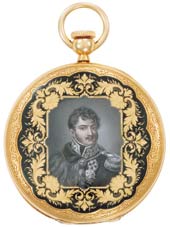
The Polish prince Joseph Antoine PONIATOWSKI (1763-1813) fought in Napoleon’s army. He was posthumously titled Marshal of France after drowning at the battle of Leipzig (1813), which NAPOLEON Ist lost against the Allies.
The most patriotic works by Patek, Czapek & Cie (1839-1845) and by Patek & Cie (1845-1851) include a stem-winding hunter watch adorned with miniature portraits on enamel of General Kosciusko, a leading figure of the Polish resistance, and Prince Poniatowski, who fought with Napoleon (1848, Inv. P-898). Polish Christianity is the subject of many pieces with religious themes, such as a miniature hunter-cased pendant watch from 1850, sold to Marie II of Bragança, queen of Portugal; and presenting an allegory of the Theological Virtues (Faith, Hope and Charity) in a miniature painting on enamel by Lamunière (Inv. P-29).
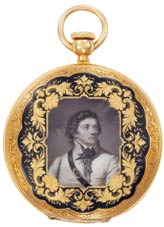
The general KOSCIUZKO - The Prince PONIATOWSKI PATEK & Co, Geneva, N° 1’388. Hunting-case keyless-winding pocket watch. Enamel by Gaspard LAMUNIERE (1810-1865), Geneva - 1848. The Polish general Tadeusz KOSCIUZKO (1746-1817), soul of the resistance against the Russians (1792 et 1794), was made prisonner and then freed by the tzar PAUL Ist (1754-1801) before retiring to Switzerland where he died.
Adrien Philippe
inventor of the stem-winding system
In Paris in 1844, Antoine Norbert de Patek met the man who would become
his next business associate. The French horologist, Adrien Philippe, was
there to attend the great French industrial exhibition, where he presented
a revolutionary device: an integrated system for winding and setting a
watch without a separate key. Impressed by this innovative flair, Patek
proposed that he join the watchmaking firm, of which he became joint partner
upon Czapek's departure in 1845.The two founders of the Patek Philippe
firm shared a common goal: to create the world's finest timepieces. This
ambition was so apparent in their work that one of the firm's first keyless
watches won the heart of Queen Victoria at the Crystal Palace Exhibition
in London in 1851.
Open-face pendant watch no. 4536 was offered to Queen Victoria, who would later be known as the " grandmother of Europe ". The story goes that the glorious blue of its enamel work, exactly the same colour as that of her eyes, charmed the Queen quite as much the technical beauty of its patented stem-winding system (1850, Inv. P-24).
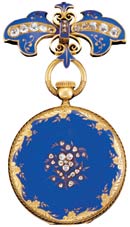
"Invention Brévetée de Patek Philippe & Co à Genève" Patek, Philippe & Co, Geneva, N° 4’536 Open-face keyless-winding patented invention fob-watch with matching brooch - 1850. This watch was presented to the Queen Victoria (1819-1901), during the "Great Exhibition" of London at Hyde-Park (Crystal Palace), on August 18, 1851. (PP mag. N° 09)
Patek Philippe,
watchmaker to leaders
Queen Victoria was far from being the only influential figure to conceive
an imperative desire for a Patek Philippe timepiece. As emblems of all
that was finest in horology, the Geneva firm's timepieces attracted numerous
crowned heads and faithfully accompanied some of the greatest minds of
the nineteenth and twentieth centuries. Intellectuals, explorers, musicians,
philosophers, writers and poets shared their passion with wealthy collectors,
heads of State and business leaders, all of whom wished to possess an
object of art and science of such outstanding technical and aesthetic
worth.
In displaying the " historical timepieces " that shared the lives of eminent figures, the PATEK PHILIPPE MUSEUM reveals an intimate facet of Leo Tolstoy and Rudyard Kipling, Richard Wagner and Pyotr Ilyich Tchaikovsky, Marie Curie and Albert Einstein,and other epic figures of intellectual and political life during the past two centuries. One discovers, for example, the open-face pocket chronometer, its movement protected by an anti-magnetic inner shield of soft iron (1926, Inv. P-120), that accompanied the American polar explorer, Admiral Richard Evelyn Byrd, on his Antarctic expeditions.
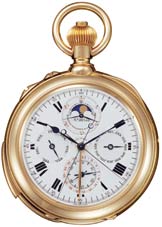
Patek Philippe & Co, Geneva, N° 197’542 Open-face keyless-winding pocket watch with minute-repeater on three gongs, perpetual calendar with phases and age of the moon, double chronograph with double recorder of 30 minutes at 12 and alarm - 1921-23. Delivered on October 29, 1925 to G. Haag & Figlio.
From Art Nouveau...
At the end of the nineteenth century an art noveau emerged in Europe,
refusing the prevailing technical hierarchy, and defending the noble status
of the decorative arts. Under its influence, furniture, paintings, and
objects drew on a wide range of decorative techniques. Their scrolls and
sinuous curves, inspired by the plant world, were highlighted by the most
precious materials. Taking their example from the glass-worker, the goldsmith
and the jeweller, whose professions soared at this time, watchmakers paid
tribute to this new source of inspiration, the graceful forms of Nature.
Typical of the period is the " rhinoceros scarab and trumpet flowers " hunter-cased, stem-winding pocket watch with push-piece operated minute repeater. This watch, which was sold on May 16th 1900 by Patek, Philippe & Cie was redecorated in polychrome champlevé enamels in the purest Art Nouveau style by the French jewellery designer, René Lalique
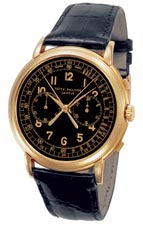
Patek Philippe & Co, Geneva, N° 867’857, Ref. 2512 Rectangular push-pieces split-seconds chronograph aviator’s wristwatch, 30 minutes recorder at 3 and tachometer scale - 1952. Delivered on July 14, 1952 to Astrua & Cia, Torino (Italia).
...to Art Deco
Art Nouveau had wilted by the end of the First World War. Its place was
taken by Art Deco, inspired by the bold geometry of the avant-garde cubists,
futurists and constructivists, which expressed a fascination for speed,
energy and pure colour. The search for functional simplicity was accompanied
by a marked preference for new materials. Chromium and Bakelite entered
the watchmaker's workshop, together with hard stone, horn and ivory.
The geometric flair of the Art Deco style is embodied in this octagonal dress watch by Patek, Philippe & Cie, whose black onyx case is centred with a sardonyx cameo ( 1923, Inv. P-103).
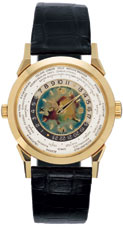
Patek Philippe & Co, Geneva, N° 720’303, Ref. 2523-1 HU "World Time" gentleman’s wristwatch with two crowns indicating the name of 41 cities, regions or countries of the world with polychrome cloisonné enamel dial representing the map of Europe - 1955. Sold on August 10, 1955.
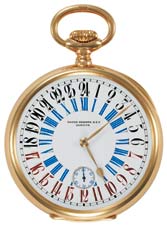
Patek, Philippe & Co, Geneva, N° 153’394 Open-face keyless-winding Chronometro Gondolo pocket watch with double 24 hour dial - 1925.
The " Chronometro
Gondolo "
In Brazil, the early twentieth century saw the opening of a most unusual
Patek Philippe Club. From 1902 to around 1930, its members, all keen enthusiasts
of fine horology, drew lots for the " Chronometro Gondolo ", purchased
by weekly lottery installments of ten dollars placed by each member for
seventy-nine weeks.This highly original version of lottery-selling was
devised by Maison Gondolo & Labouriau, distributors in Rio. Patek Philippe
enjoyed such renown in the region ( as it did everywhere in Latin America)
that when referring to a watch, the local inhabitants simply called it
" a Patek ". Over a period of thirty years, the Chronometro Gondolo acquired
many different personalities.
An open-face stem-winding Chronometro Gondolo pocket watch from 1925 has a stunning double twenty-four-hour dial, with two chapter rings (Inv. P-1187).
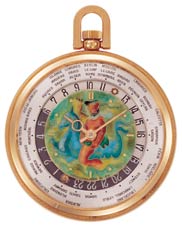
Patek Philippe & C0, Geneva, N° 930’365, Ref. 605 HU "World Time" open-face keyless-winding dress-watch indicating the name of 42 cities, regions or countries of the world with polychrome cloisonné enamel dial representing Neptune riding a sea-horse - 1945. Delivered on November 14, 1945 to Th. Beyer, Zurich (Switzerland).